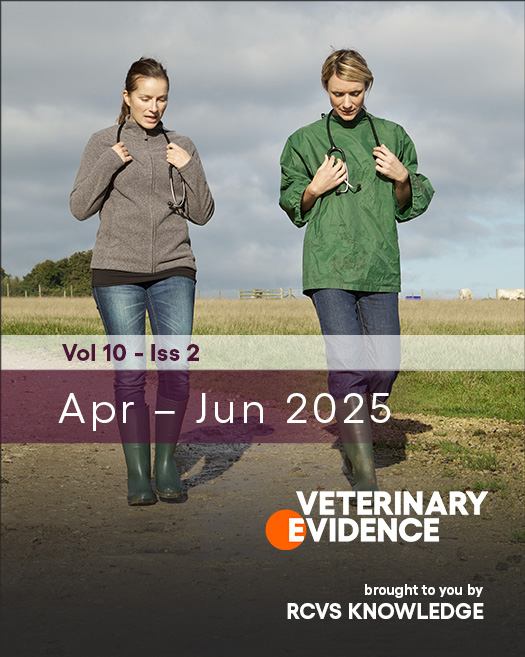DOI
https://doi.org/10.18849/ve.v10i2.709Abstract
Question
In dogs with a gastric dilatation volvulus (GDV) treated surgically and undergoing a gastropexy, what is the rate of recurrence of GDV?
Clinical bottom line
The category of research question was:
Risk.
The number and type of study designs that were critically appraised were:
Sixteen studies were critically appraised. Two were prospective randomised controlled trials, two were prospective cohort studies, one was a case-control study, and eleven were case series.
Critical appraisal of the selected papers meeting the inclusion criteria collectively provide zero/weak/moderate/strong evidence in terms of their experimental design and implementation:
Weak.
The outcomes reported are summarised as follows…
A low rate of recurrence of GDV after gastropexy was consistently reported, although methodological limitations were recognised in all studies.
In view of the strength of evidence and the outcomes from the studies the following conclusion is made…
Overall, the studies provide weak evidence that the rate of recurrent GDV is low after gastropexy.
References
Belandria, G.A., Pavletic, M.M., Boulay, J.P., Penninck, D.G. & Schwarz, L.A. (2009). Gastropexy with an automatic stapling instrument for the treatment of gastric dilatation and volvulus in 20 dogs. The Canadian Veterinary Journal. 50(7), 733–740.
Belch, A., Rubinos, C., Barnes, D.C. & Nelissen, P. (2017). Modified tube gastropexy using a mushroom-tipped silicone catheter for management of gastric dilatation-volvulus in dogs. Journal of Small Animal Practice. 58(2), 79–88. DOI: https://doi.org/10.1111/jsap.12615
Benitez, M.E., Schmiedt, C.W., Radlinsky, M.G. & Cornell, K.K. (2013). Efficacy of Incisional Gastropexy for Prevention of GDV in Dogs. Journal of the American Animal Hospital Association. 49(3), 185–189. DOI: https://doi.org/10.5326/jaaha-ms-5849
Dettori J.R. (2011). Loss to follow-up. Evidence-Based Spine-Care Journal. 2(1), 7–10. DOI: https://doi.org/10.1055/s-0030-1267080
Eggertsdóttir, V., Stigen, Ø., Lønaas, L., Kolbjørnsen, Ø. & Moe, L. (1996). Comparison of Two Surgical Treatments of Gastric Dilatation-Volvulus in Dogs. Acta Veterinaria Scandinavica. 37(4), 415–426. DOI: https://doi.org/10.1186/BF03548081
Eggertsdóttir, A.V., Stigen Ø., Lønaas, L., Langeland, M., Devor, M., Vibe-Petersen, G. & Eriksen, T. (2001). Comparison of the recurrence rate of gastric dilatation with or without volvulus in dogs after circumcostal gastropexy versus gastrocolopexy. Veterinary Surgery. 30(6), 546–551. DOI: https://doi.org/10.1053/jvet.2001.28439
Formaggini, L. & Degna, M.T. (2018). A Prospective Evaluation of a Modified Belt-Loop Gastropexy in 100 Dogs with Gastric Dilatation-Volvulus. Journal of the American Animal Hospital Association. 54(5), 239–245. DOI: https://doi.org/10.5326/jaaha-ms-6596
Funkquist, B. (1979). Gastric torsion in the dog. III. Fundic gastropexy as a relapse-preventing procedure. Journal of Small Animal Practice. 20(2), 103–109. DOI: https://doi.org/10.1111/j.1748-5827.1979.tb05945.x
Glickman, L.T., Glickman, N.W., Pérez, C.M., Schellenberg, D.B. & Lantz, G.C. (1994). Analysis of risk factors for gastric dilatation and dilatation-volvulus in dogs. Journal of the American Veterinary Medical Association. 204(9), 1465–1471.
Glickman, L.T., Lantz, G.C., Schellenberg, D.B. & Glickman, N.W. (1998). A prospective study of survival and recurrence following the acute gastric dilatation-volvulus syndrome in 136 dogs. Journal of the American Animal Hospital Association. 34(3), 253–259. DOI: https://doi.org/10.5326/15473317-34-3-253
Jennings Jr, P.B., Jr. & Butzin, C.A. (1992). Epidemiology of gastric dilatation-volvulus in the military working dog program. Military Medicine. 157(7), 369–371.
Leib, M.S., Konde, L.J., Wingfield, W.E. & Twedt, D.C. (1985). Circumcostal gastropexy for preventing recurrence of gastric dilatation-volvulus in the dog: an evaluation of 30 cases. Journal of the American Veterinary Medical Association. 187(3), 245–248. DOI: https://doi.org/10.2460/javma.1985.187.03.245
Mann, F.A., Pan, Y., Middleton, J.R., Chairez, C.K. & Pyne, C. (2023). Comparison of incisional gastropexy with and without addition of two full-thickness stomach to body wall sutures. Journal of the American Veterinary Medical Association. 261(9), 1351–1356. DOI: https://doi.org/10.2460/javma.22.11.0492
Meyer-Lindenberg, A., Harder, A., Fehr, M., Lüerssen, D. & Brunnberg, L. (1993). Treatment of gastric dilatation-volvulus and a rapid method for prevention of relapse in dogs: 134 cases (1988–1991). Journal of the American Veterinary Medical Association. 203(9), 1303–1307.
Przywara, J.F., Abel, S.B., Peacock, J.T. & Shott, S. (2014). Occurrence and recurrence of gastric dilatation with or without volvulus after incisional gastropexy. The Canadian Veterinary Journal. 55(10), 981–984.
Rawlings, C.A., Mahaffey, M.B., Bement, S. & Canalis, C. (2002). Prospective evaluation of laparoscopic-assisted gastropexy in dogs susceptible to gastric dilatation. Journal of the American Veterinary Medical Association. 221(11), 1576–1581. DOI: https://doi.org/10.2460/javma.2002.221.1576
Ullmann, B., Seehaus, N., Hungerbühler, N. & Meyer-Lindenburg, A. (2015). Gastric dilatation volvulus: A retrospective study of 203 dogs with ventral midline gastropexy. Journal of Small Animal Practice. 57(1), 18–22. DOI: https://doi.org/10.1111/jsap.12406
Wacker, C.A., Weber, U.T., Tanno, F. & Lang, J. (1998). Ultrasonographic evaluation of adhesions induced by incisional gastropexy in 16 dogs. Journal of Small Animal Practice. 39(8), 379–384. DOI: https://doi.org/10.1111/j.1748-5827.1998.tb03736.x
License
Copyright (c) 2025 Daniel Low

This work is licensed under a Creative Commons Attribution 4.0 International License.
Veterinary Evidence uses the Creative Commons copyright Creative Commons Attribution 4.0 International License. That means users are free to copy and redistribute the material in any medium or format. Remix, transform, and build upon the material for any purpose, even commercially - with the appropriate citation.
Most read articles by the same author(s)
- Daniel Low, Does early neutering increase the risk of cranial cruciate ligament rupture? , Veterinary Evidence: Vol. 9 No. 2 (2024): The second issue of 2024
